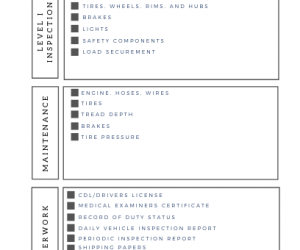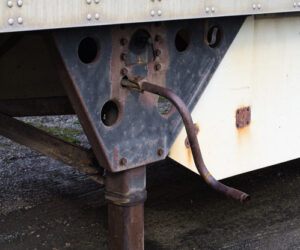In April 2018, the United States and Canadian Commercial Vehicle Safety Alliance (CVSA) j organized 11,531 roadside commercial motor vehicle inspections on Brake Safety Day, April 25, 2018; from the 11,531, about 1,595 commercial motor vehicles were removed because of brake violations.

From this data, the United States and Canada gathered the following statistics:
- 11,531 inspections were organized during Brake Safety Day.
- 52 jurisdictions contributed to the inspections, including 41 states in the U.S. and 11 Canadian territories/provinces.
- 1,595 commercial vehicles were removed from the road (received an out-of-service order) because of brake violations. That totals 13.8 percent of the vehicles inspected.
- The United States performed 10,074 inspections, and Canada inspected 1,457 vehicles.
- 14 percent of U.S. vehicles and 12.4 percent of Canadian vehicles were removed from the road for brake violations.
- 86.2 percent of commercial motor vehicles were inspected and did not have any brake-related issues.
Jurisdictions also reviewed anti-lock braking systems (ABS) and gathered the following statistics.
- 5,331 trailers required ABS; approximately 14.3 percent had ABS violations.
- 8,128 air-braked trucks and tractors needed ABS; roughly 10.2 percent had ABS violations.
- 95 buses needed ABS; approximately 2.1 had ABS violations.
- 1,299 hydraulic-braked trucks required ABS; roughly 3.5 percent had ABS violations.
The CVSA conducts brake inspections each year to help find and remove vehicles that are operating with brake issues. Doing these inspections helps lower the number of commercial vehicle-related accidents.
The DOT’s FMCSA Large Truck Crash Causation Study shows that larger trucks with a brake violation are more likely to be involved in an accident than those without any violations. About 45.5 percent of trucks in critical accidents had brake issues. However, 29.9 percent of trucks involved in the same type of accident did not have brake violations.
By conducting the Brake Safety Day, more drivers, mechanics, and owner-operators are better educated about the importance of brake inspections, maintenance, operation, and overall safety.
The CVSA will conduct a Brake Safety Week from September 16 – 22, 2018, in all participating jurisdictions in North America. As the Brake Safety Week approaches, be sure your truck meets the CVSA inspections.
CVSA Inspection Levels
Read these inspection levels to ensure your truck does not receive an out-of-order sticker and is kept on the road during Brake Safety Week.
Level I – North American Standard Inspection
During Level I inspection, inspectors will examine your driver’s license, medical examiner’s certificate, and skill performance evaluation certificate. Inspectors will also ensure you are not under the influence of drugs or alcohol. Your driver’s record and hours of service will also be checked, along with proper working seat belts and up-to-date vehicle inspections. Vehicle inspections include:
- Brake system
- Cargo securement
- Coupling devices
- Driveline/driveshaft
- Exhaust systems
- Frames
- Fuel systems
- Lighting devices – headlamps, stop lamps, turn signals, and lamps/flags on projecting loads
- Steering mechanisms
- Suspensions
- Tires
- Van and open-top trailer bodies
- Wheels
- Rims
- Hubs
- Windshield wipers
- Buses
- Passenger Vans
- Other passenger-carrying vehicles
- Emergency exits
- Electrical cables
- Systems in the engine
- Battery compartments
- Seating
- HM/DG and specification cargo tank requirements
* Note: If there is more than a 20 percent pushrod travel that cannot be measured, the inspection would then be a Level II inspection.
* Note: Under the 20 percent brake standards – five-axle vehicles with a combination of one axle that is not measured will need two defective brakes to receive an out-of-service order.
Level II – Walk-Around Driver/Vehicle Inspection
During a Level II inspection, an inspector examines everything in the Level I inspection. In addition to a Level I inspection, you can expect a walk-around driver/vehicle inspection. The walk-around driver/vehicle inspection includes items that can be inspected without getting under the vehicle.
Level III – Driver/Credential/Administrative Inspection
Level III inspections include examining the:
- Driver’s license
- Medical Examiner’s Certificate
- Skill Performance Evaluation (SPE) Certificate
- Driver’s record – duty status
- Hours-of-Service regulations
- Seat Belt
- Vehicle inspection
- Motor Carriers identification and status
* Note: Items inspected in the Level I and Level II inspections should not be included during the Level III inspection. If traffic violations are found, the inspection will consist of the Level III inspection.
Level IV – Special Inspections
Level IV Special Inspections includes a one-time exam of one specific item. This provides something that was conducted during a study or to confirm or contest a suspected fad.
Level V – Vehicle-Only Inspection
In a Level V inspection, an examiner inspects a specific item under the Level I – North American Standard Inspection when the driver is not present at any location.
Level VI – North American Standard Inspection for Transuranic Waste and Highway Route Controlled Quantities (HRCQ) of Radioactive Material
Level VI inspection is for radiological shipments, which includes the Level I Inspection, radiological requirements, and the North American Standard Out-of-Service regulations for Transuranic Waste and Highway Route Controlled Quantities of Radioactive material.
On January 1, 2005, commercial vehicles and carriers that carried HRCQ of radioactive material were controlled by the United States Department of Transportation (DOT), and the vehicle must pass the North American Standard Level VI Inspection.
Level VII – Jurisdictional Mandated Commercial Vehicle Inspection
A Level VII inspection is required for a jurisdictional-mandated inspection program that does not meet the criteria of any other level inspections. An example of this would include:
- School buses
- Limousines
- Taxies
- Shared-ride transportation
- Hotel shuttles
- Intrastate/intra-provincial operations
The inspections are performed by the CVSA-certified inspectors, government employees, or jurisdiction-approved contractors.
Level VIII – North American Standard Electronic Inspection
A Level VIII is an inspection that includes inspections under the North American Standard Electronic Inspection Procedure. Electronic inspections include, when required:
- GPS coordinates
- Descriptive locations
- Electronic validation of the operator
- Driver’s license class and endorsement(s)
- License status
- Medical Examiner’s Certificate
- Skill Performance Evaluation (SPE) Certificate
- Driver record of duty status
- Hours-of-service
- Canada or USDOT NSC number
- Power unit registration
- Operating authority
- Unified Carrier Registration (UCR)
- Federal out-of-service orders
The Level VIII North American Standard Inspection is controlled wirelessly or electronically. At the same time, the vehicle is still in motion without any interaction with an enforcement officer. To complete a Level VIII Inspection, the data received must meet the requirements of the CVSA North American Standard Level VIII Electronic Inspection.
Before hitting the open road, be sure your truck is operating correctly by conducting a pre-trip inspection. Your truck should meet all the requirements under the Commercial Vehicle Safety Alliance Inspection guidelines. DOT Inspection Levels include Level I – Level VI in the CVSA inspection list. Pre-inspections reduce time spent on out-of-service restrictions and help get you back home to your family quickly and safely.



 March 25, 2020, the Commercial Vehicle Safety Alliance (CVSA) decided to postpone the 2020 International Roadcheck due to the grow...
March 25, 2020, the Commercial Vehicle Safety Alliance (CVSA) decided to postpone the 2020 International Roadcheck due to the grow...

